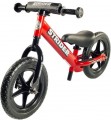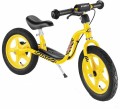Wheels
The design of the wheels fitted to a bicycle and the materials used for the tyre/rim.
—
Inflatable rubber. Wheels with inflatable rubber tires — the same as those on full-size adult bicycles. Such wheels are quite demanding in terms of maintenance: their condition must be monitored and pumped up if necessary. In addition, even a small puncture in the tire makes it unusable and requires repair. On the other hand, this is the most advanced type of wheel in terms of performance: they perform well even on uneven roads, smooth out vibrations, provide good traction and are suitable for fast, dynamic riding. And servicing inflatable tires can be a good training for a young cyclist before switching to a teenage bike. That is why two-wheeled models for older age groups are mainly equipped with inflatable tires. However, this option can also be found in other varieties, including balance bikes and even three-wheeled ones (see "Type").
—
Rubber. Wheels with a solid rubber tire. Unlike the inflatable ones described above, such tires do not need to be inflated, and they are completely resistant to scratches and punctures. On the other hand, solid rubber wheels are less suitable for uneven roads and high loads. Therefore, they are found mainly among bicycles for the smallest, and in the age category from 5 to 8 years, such wheels are not used at all.
— Polyurethane. In design, such wheels
...are similar to solid rubber ones (see above), they differ only in the tire material — polyurethane (elastic synthetic material). Polyurethane is noticeably harder than rubber, so it is used mainly in tricycles, not designed for fast driving and uneven roads.
— Plastic. Wheels made entirely of plastic. The main advantage of this material is its low cost; in addition, it can be given almost any color. On the other hand, plastic is hard and not very durable, it is not suitable for uneven roads and high speeds. Therefore, such wheels are used only in tricycles and some balance bikes (see "Type").
— Plastic with rubber. A slightly improved version of the plastic wheels described above. In this case, the hard plastic is supplemented with a kind of tire analogue — a narrow rubber strip around the rim, where the wheel touches the ground while driving. This helps to soften the vibrations that inevitably occur even when driving on smooth asphalt, but this is essentially where these wheels differ from purely plastic ones — plastic with rubber is also used only in tricycles, where the wheels are not designed for significant loads.Cast wheels
In the context of children's bicycles,
alloy wheels refer to monolithic wheels made by injection molding. This is where they differ from traditional wheels, where the rim and hub are connected by spokes. Alloy wheels are typically stronger and more resistant to damage, and with fewer moving parts, they are easier to maintain.
Rear brake
—
Pedal. A variant used mainly in two-wheeled models (see "Type"). To brake, you need to press the pedals in the opposite direction; the braking itself is provided by the pads inside the rear hub. Pedal brakes are simple, inexpensive, do not require maintenance and are quite reliable, which is why they are extremely popular in children's bicycles. Their main disadvantage is that if the chain falls off, the bicycle loses the rear brake; however, the probability of this is not so high that this moment is critical.
— Rim mechanical. A brake in the form of a pair of pads, which are pressed against the wheel rim by pressing the handle (
manual type of brake); the force from the handle is transmitted by mechanical traction in the form of a cable (hence the name). Such brakes, unlike the pedal brakes described above, work even with a chain that has come off. At the same time, they are more complex, more expensive and require periodic maintenance, which is why they are rare, mainly in fairly advanced models of the older age category.
—
Disc. A brake in the form of a pair of pads, which, when pressed on the handle, are pressed against a special disk fixed on the wheel hub. The force from the handle to the pads is transmitted through mechanical traction, as in rim mechanical ones. However, disc brakes are considered more advanced — they are more powerful, more e
...fficient, and less sensitive to dirt and rim curvature. On the other hand, such systems are more complex and more expensive than rim ones, which is why they are used extremely rarely — mainly in high-end two-wheeled bicycles of the older age category.
— Trigger sleeve. A type of brake that combines the features of the two types described above: the pads are located inside the drum in the rear sleeve (like in pedal brakes), but the braking force is transmitted to them not from the pedals via a chain, but from the handle on the steering wheel via a cable (like in rim mechanical brakes). Due to this, such brakes can be installed on balance bikes (see "Type"), where pedals are absent by definition; in fact, trigger sleeve systems were created specifically for balance bikes.
— Pedal and rim. Bicycles equipped with both a pedal and rim rear brake. For more information on each of these types, see above; and their combination is used to increase the efficiency and safety of braking. Thus, a bicycle with such equipment is not afraid of a chain falling off: the pedal brake will fail, but the rim brake will remain functional. And the simultaneous use of two brakes can be useful for an emergency stop. On the other hand, such a combination significantly affects the price of the bicycle, despite the fact that in practice it is not needed so often. Therefore, this option has not become very widespread.
— Handbrake. A type of brake used exclusively on tricycles. It looks like a lever, usually mounted to the side of the seat; when this lever is raised, special stoppers are lowered onto the rear wheels. Note that tricycles are not designed for high speeds, and to brake, it is often enough to slow down the movement of the feet on the pedals. In light of this, the handbrake is provided more for “just in case” than for regular use; in some models, it can be used as a parking brake.
— Parental. A variant used in the youngest age group of tricycles, equipped with a parental handle (see below). As the name suggests, in such models the brake is controlled by the parent leading the bicycle — for example, by pressing a special lever on the parental handle.Footrest
A special
stand on which the child can put his feet while sitting on a bicycle. It is found exclusively in three-wheeled models (see "Type") equipped with a parent handle (see above), and is another "pram" function: when the parent pushes the car, it is inconvenient and sometimes unsafe for the baby to keep his feet on the pedals. do not confuse this feature with a
bicycle footrest, which allows you to put the bike on your own without a stop.

